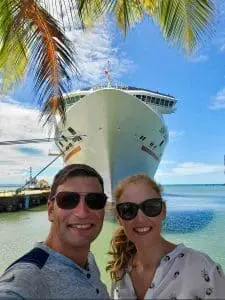 You’re compiling your bucket list and you’ve written that dream vacation down, but there’s a sudden feeling of dread which courses through you. For many of us going on a cruise is the epitome of luxury and opulence, and something we dream of doing once in our lives. But there’s one thing that puts many would be cruisers off from setting sail, and that is seasickness.
You’re compiling your bucket list and you’ve written that dream vacation down, but there’s a sudden feeling of dread which courses through you. For many of us going on a cruise is the epitome of luxury and opulence, and something we dream of doing once in our lives. But there’s one thing that puts many would be cruisers off from setting sail, and that is seasickness.
We can remember the same thoughts crossed our mind when we booked our first cruise. To start with we only chose a four nighter to the Bahamas, because in the back of our minds we felt we could cope that long if the sea sickness was really bad.
Our past experiences of boats had given us the extreme anxiety we felt, because boy had we been ill. Whether it was a Pedalo in Spain, or the Staten Island ferry in New York, each time we found ourselves with our heads down trying to keep the nausea at bay and praying for it to end.
It’s worth noting here that a cruise ship is a very different vessel to a pedalo, so our comparisons were a little unfair. Rather than fill you with more dread we can confirm that our first cruise was incredible and went without a hitch; or the need for a sickness bag.
If you’re the bucket lister who dreams of ticking off a cruise, then let us help you with our guide on how to prevent seasickness on a cruise. We have personally used many of these remedies, so within the article we’ll tell you whether they worked for us or not. What we would suggest is that you seek medical advice if you’re concerned, because your doctor may be able to provide support.
If you are considering a cruise, then check out our guides on ‘What to Pack for a Cruise’ and ‘First Time Cruise Tips’.
Ad Disclaimer!
This website uses paid adverts and affiliate links, these come at no additional cost to you and help us to fund the operation of the website, meaning we can continue to provide you with valuable content.
The money received from these links and adverts do not influence any recommondations made within our content.
Page Contents
What is Seasickness?
If you’ve never come across this term before, it is basically a motion sickness that you experience when travelling by sea. Not everyone is susceptible to motion sickness, and modern cruise ships have been designed to remain stable and minimise the affect of the swell of the ocean. They have stabilisers which counteract the impact of the waves on the ship to keep it steady. There are a few different types including bilge keels, fixed stabilisers and the more popular gyroscopic stabiliser which is a state-of-the-art fin system that uses onboard controls to adapt to the seas motion and any wind conditions.
This is why cruise lines are very different to many smaller vessels you may have travelled on, because they have to be adaptable to varying ocean conditions and climates. But also, they should allow passengers to travel in comfort and this can only be achieved if there is barely any motion.
What Causes Seasickness?
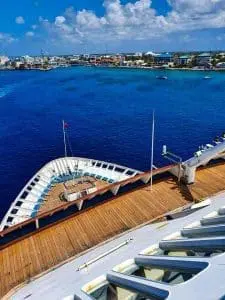 As anyone who has suffered from vertigo can attest, your ears have a huge impact on your sense of balance. For many the constant movement will affect their inner ear and it is this which creates that queasy feeling. The inner ear is part of a network named the vestibular system and includes three semicircular canals and two sacs which are called the saccule and utricle. The semicircular canals hold the fluid that moves as you turn your head to maintain your balance. The saccule and utricle are sensitive to gravity.
As anyone who has suffered from vertigo can attest, your ears have a huge impact on your sense of balance. For many the constant movement will affect their inner ear and it is this which creates that queasy feeling. The inner ear is part of a network named the vestibular system and includes three semicircular canals and two sacs which are called the saccule and utricle. The semicircular canals hold the fluid that moves as you turn your head to maintain your balance. The saccule and utricle are sensitive to gravity.
The sickness occurs because your inner ear and central nervous system sends signals to your brain that your body is moving. There is a disconnect because your eyes cannot detect the movement caused by the swell of the sea and this mismatch confuses your brain and makes you feel dizzy and sick.
Most of you will know that you can also get motion sickness from a variety of things, such as cars, trains, planes and even theme park rides.
How Likely are you to Get Seasickness?
For first time cruisers this is the main question they will be asking. Sadly, there’s no easy answer to this question, but if you don’t get motion sickness generally then you have a better chance when you’re on the ocean. Remember that as we explained above, modern cruise lines are built to minimise any motion.
We’ve told you about our first cruise but it’s worth noting the second cruise we did around the Caribbean. During the trip there was a Nor’easter which is a large-scale cyclone which had impacted most of the east coast of America and the Atlantic Ocean. This cyclone created huge waves, but only one of the four in our party felt seasick and had to lie down.
Since that trip we have sailed a number of times and only had one other occasion where we struggled, which was during a storm as we headed up the English Channel from Southampton to Norway. Again, only one of us felt affected by seasickness and both times it was during excessive forms of weather. Remember unless it’s a sea day, most of the time you’re in a port where the ship is docked and there’s little movement.
If you suffer badly from sea sickness, it can feel quite debilitating, we know that we had to simply go to bed and sleep it out. The minute we lay down we felt fine and easily fell asleep. Other people can experience rough seas and be ok, which means they can continue to enjoy the entertainment no matter the weather.
For most who suffer from general seasickness, you may feel a little queasy at first, but then eventually your sea legs will kick in and your body will acclimatise to the movement. Before that happens, there are effective remedies which we’ll go through with you below. It’s better to prepare yourself just in case, because feeling seasick can really dampen your holiday.
We’re not going to lie, even with the incredible technology that is found on cruise ships, you will feel a little motion. We say this because we were regularly told that you won’t feel the ship move, which isn’t always accurate, but that doesn’t mean it will make you feel ill. There are a number of factors which will influence the motion of the ship, including the weather and the area of the world you’re sailing in.
What are the Symptoms of Seasickness?
From our experience, seasickness is pretty much feeling lightheaded, with nausea which is caused by the dizziness. The minute we lay down in our cabin, that went away, and we felt back to normal, but it returned if we stood up. It also meant we lost our appetite, so the best thing to do was sleep.
Most people will experience the same symptoms, but they may also get a headache, stomach cramps, and vomiting. Because of the nausea some experience a loss of appetite and feel very tired. We found that the rocking of the ship made it easy to fall asleep.
How to Prevent Seasickness During Your Cruise – Remedies and Recommendations
 You now know what seasickness is and what causes it, but we’re sure you’re eager to know how to prevent it from happening during your cruise vacation. These are a few remedies which you may find useful, they include seasickness medications and natural treatments, as well as general recommendations. If you’re considering taking medications then please seek advice from your doctor or pharmacist, especially if you’re taking other medications.
You now know what seasickness is and what causes it, but we’re sure you’re eager to know how to prevent it from happening during your cruise vacation. These are a few remedies which you may find useful, they include seasickness medications and natural treatments, as well as general recommendations. If you’re considering taking medications then please seek advice from your doctor or pharmacist, especially if you’re taking other medications.
We use a number of these treatments, but we start off with the simpler more natural ones, only taking medications if needed.
Choose the Right Location for Your Cruise Cabin
Ok so our first recommendation isn’t a medicine or natural remedy, it’s purely down to our experience from past cruises. Where you pick your cabin can have an impact on how you feel and prevent seasickness. If you’re concerned you may struggle, then it’s wise to consider your staterooms location before you board the ship.
The consensus between cruisers is that the best cabins for people who suffer from seasickness are in the middle of the ship and close to the waterline. As we’ve mentioned above, ocean cruise ships are designed to remain stable, but whatever movement that is felt, is lessened towards the centre of the ship. Both the bow and the stern will experience more movement and as such it can add to that general feeling of being unwell.
As to whether you’ll feel better in a balcony room or inside cabin is also up for debate. Inside tends to be more central to the ship, but with a balcony room you can look at the views and help that confused brain to realise its moving, which should reduce the nausea.
If this area of the ship is already booked up, then the next option is an aft or mid aft cabin. Aft is another word for the back of the ship, and it’s a better choice because the movement is less severe than the front.
For those of you who want to make it special and are looking at booking a suite, then you’ll find most of them will be at the front or back of the ship on the higher decks; purely because of the room needed. But you will find some dotted in the middle lower decks, so if you’re prone to motion sickness then get in there fast so you can choose the best spot.
Buy Travel Sickness Bands – Seabands or Acupressure Band
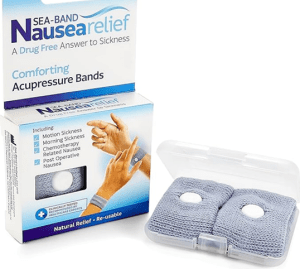 Seabands are second on our list, because we’re huge fans of them and they have helped us a lot with motion sickness. We initially used them to help combat the nausea we felt on rollercoasters. One of our friends recommended them as she had used them during her pregnancy.
Seabands are second on our list, because we’re huge fans of them and they have helped us a lot with motion sickness. We initially used them to help combat the nausea we felt on rollercoasters. One of our friends recommended them as she had used them during her pregnancy.
Of course, they worked wonders, in fact we found ourselves going on the most extreme rollercoasters and feeling a tad dizzy but with no nausea. So, it made sense to take them with us when we embarked on our first cruise. Again, they really helped, and even though they look like the wrist sweat bands you’d envisage Madonna wearing in the 80’s, it didn’t matter because they made us feel good.
Otherwise known as sickness bands or acupressure bands, a Seaband is basically a knitted elasticated wrist band with a small plastic stud on it. The stud is found on the inside of the band and when you put them on, you place the stud so that it presses into the middle of your inner wrist. This is said to stimulate the Pericardium 6 (known as the P6) or Nei-Kuan acupressure point. It is this pressure which is proven to help relieve nausea and vomiting.
For the best results put on the bands before you board and then keep them on. They tend to take a few minutes to become effective, but if you need more relief then you can apply extra pressure to the plastic stud.
If your Seaband gets a little dirty, then you can always throw them in the wash. We love this option because it’s natural and reusable, plus they can be worn by children and adults. This is handy because children can be more prone to motion sickness then adults.
If you’re planning your first cruise then we recommend buying these as a minimum, because in reality they’re a cheap solution which works for many people, including us.
We bought this Sea-Band Nausea Relief Acupressure Wristband from Amazon, but they have a variety of them at varying prices for adults and children.
Seasickness Medication
One of the obvious options to stop seasickness, is to buy over the counter medication and patches, or to go to your doctor for prescribed medication. We’re not medical professionals and as such we cannot give medical advice, but we have taken some brands of seasickness medication and found they really worked for us during incredibly rough seas. If you’re already on medication, then it’s wise to get medical advice.
The options available will vary from country to country, with popular options in the UK being Kwells, Stugeron or Scopoderm patches. But we have also seen Bonine or Dramamine mentioned by cruising enthusiasts.
Many contain Hyoscine which works by affecting your inner ear and brain to control vomiting and relaxing the muscles of your stomach wall.
Again, remember to talk to your doctor or pharmacist and keep any medications in your hand luggage because you may have to wait for your bags on the day you board, so it’s safer to keep essential items such as pills with you.
If you forget to bring any medication with you then the shops onboard sometimes stock them, or you could ask the medical staff. We were told by a friend that they were given an injection by medical staff on their cruise which helped stop their nausea, but this will come at a cost, so it’s better to be prepared beforehand.
Choose a Cruise Itinerary with Calm Waters
 This one will depend on a few things, the main one being where you wanted to travel during your cruise. If it’s your first time and you’re worried about being seasick then it may be best to avoid trans-Atlantic cruises. But if that’s on your bucket list and you’re eager to tick it off, then the other options on this list should help.
This one will depend on a few things, the main one being where you wanted to travel during your cruise. If it’s your first time and you’re worried about being seasick then it may be best to avoid trans-Atlantic cruises. But if that’s on your bucket list and you’re eager to tick it off, then the other options on this list should help.
As you can imagine the ocean is unpredictable and storms can happen anytime. So even though you may be advised of a specific area to sail, it doesn’t mean that it’s a given. There are some areas which tend to be calmer most of the time and these are the Gulf of Mexico and Caribbean cruises. We also found European cruises which hug the coast are generally quite smooth. There are certain areas though which are renowned for being choppy including the Atlantic, the Bay of Biscay, but also the English Channel and North Sea.
Be aware of the time of year that you sail because the Caribbean can be worse during hurricane season and European waters during the wintertime. Our advice would be to research the cruise itinerary you like and see what cruising experts say. Another option is to join social media groups and ask others of their experiences. You will find that for most cruise itineraries, someone has started a Facebook group so that people can connect, make friends, and plan events when they’re on board. It’s also a great place to ask questions because many cruisers sail the same routes more than once and will be able to share their experiences.
We have done a variety of cruises including the Caribbean, Greece, around Italy and from the UK to the Norwegian Fjords, and for each we have had a very different experience, so it can be difficult to predict. All you can do is choose the cruise which suits everything you want and take the medication or natural remedies for the ‘just in case’.
If you book a cruise to Norway, then check out our ‘What to Pack for a Norwegian Fjords Cruise’ which covers all the essentials and more.
Get Some Fresh Air
As we mentioned in the section above ‘What Causes Seasickness’, the nausea and dizziness that can be experienced occurs because there is a disconnect between the ears and eyes. The ears have told your brain that you are moving, but your eyes cannot detect any movement which makes your brain confused. One of the best ways to resolve this is by leaving your room and getting into the fresh air so you can watch the horizon and waves, which will tell your eyes and brain that everything is normal. If the waves are substantial then this can make things worse, so just have a try and see how you feel.
One suggestion we have seen to help acclimatise quicker is to stand with your legs further apart to help balance you, without holding onto anything for support. Again, your brain will realise that it is actually moving and make the changes it needs, which should reduce the overall sickness affect.
Fresh air can also help you feel a little better, so if the standing option isn’t working, then find a chair or sun lounger in the shade and relax. Once it passes then try some water to see how settled your tummy is. Try to stay away from areas where there are strong odours such as the smoking section as this can make you feel queasier.
Eat a Green Apple
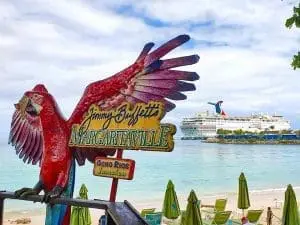 During our research we came across this natural remedy which took us by surprise, but supposedly it’s a popular option with the staff on cruise ships. Would you believe that eating a green apple such as a Granny Smith can help reduce your nausea.
During our research we came across this natural remedy which took us by surprise, but supposedly it’s a popular option with the staff on cruise ships. Would you believe that eating a green apple such as a Granny Smith can help reduce your nausea.
The science behind the green apple theory is because they are incredibly high in pectin, a soluble fibre which turns water into a thick gel in your intestines. This will slow down your digestion and neutralise the acid, which will settle your stomach. On top of that, fructose which is a natural sugar in the apple will help keep energy levels up. The best part is that you can find green apples on most cruise ships buffets, so make sure you grab a couple to keep in your room just in case you need them.
Sleep Through Your Seasickness
We will admit that the times we really struggled with seasickness, the best thing we found to do was simply go to bed. The moment we lay down it all felt so much easier, and the movement of the ship simply rocked us to sleep. The best part is that we woke up the next morning refreshed and ready to explore a new port. Simply shutting your eyes will help reduce the impact of the disconnect between your ears and eyes to your brain, and by using an eye mask and earplugs you will minimise the senses which have caused the motion sickness to begin with.
Try Ginger
 If you prefer the idea of more natural seasickness remedies, then what about ginger. This could be ginger tea, ginger gummies, powdered ginger, ginger biscuits, and even ginger beer. Ginger is said to calm upset stomachs and reduce nausea, but how exactly does it do it?
If you prefer the idea of more natural seasickness remedies, then what about ginger. This could be ginger tea, ginger gummies, powdered ginger, ginger biscuits, and even ginger beer. Ginger is said to calm upset stomachs and reduce nausea, but how exactly does it do it?
Gingerols and shogoals are compounds found within ginger which block the actions of the neurotransmitter’s acetylcholine and serotonin in the body. Acetylcholine will trigger involuntary stomach contractions and serotonin will stimulate the vomiting reflex. By the fact ginger prevents these chemicals from working, then you should find there is a reduction in the nausea you were experiencing.
You will find lots of different ginger gummies on Amazon, but we’ve been told these Chewy Ginger Candy sweets from The Ginger People are a good choice.
Try Acupuncture
There is no concrete proof that acupuncture will work for motion sickness. But if you are considering it for other ailments or therapeutic benefits, then why not mention to your therapist that you are concerned about seasickness. There is some evidence that many patients have found it helped them, so it may be an idea for those of you who are worried. This is because like Seabands, the therapist can target the Pericardium 6 on the inside of the wrist, which will help relieve the nausea.
If you’ve never had acupuncture before and you want to try it on the cruise itself, then most cruise lines will offer a taster session at the beginning of the holiday within their spa. We have previously attended one and the practitioner explained what acupuncture was and put one of the finer needles into our hand to show it was pain free. They then went through the pricing of each session and how much it would be if you purchased a number of sessions. We will admit to doing an internal gasp at the price, especially because we had enquired about acupuncture prices at a clinic close to our home and it was much cheaper.
It’s wise to check with your doctor before embarking on any natural therapies, but we can tell you from our experience that it is pretty painless.
Take Vitamin C
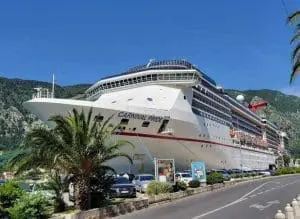 Histamine is a neurotransmitter which plays an important role in the neural process of motion sickness. It helps with the development of symptoms such as nausea and vomiting. Because of that antihistamines are a good option to help reduce the overproduction of the response in your body. But if you’re looking for something more natural than eating more foods with vitamin c in them is a great option. Vitamin c naturally inhibits histamine production and is a far healthier choice than pills.
Histamine is a neurotransmitter which plays an important role in the neural process of motion sickness. It helps with the development of symptoms such as nausea and vomiting. Because of that antihistamines are a good option to help reduce the overproduction of the response in your body. But if you’re looking for something more natural than eating more foods with vitamin c in them is a great option. Vitamin c naturally inhibits histamine production and is a far healthier choice than pills.
You’ll find vitamin c in lots of foods such as citrus fruits, tomatoes, potatoes, red and green peppers, kiwi fruit, broccoli, strawberries, and Brussel sprouts to name a few. Most cruise lines will have fruit juices on board if you want something quick and simple to help boost your daily vitamin c intake.
The Earplug Trick
This is a handy little trick we discovered as we were writing this guide, but we will definitely try it if needed on our next cruise. We’re now fully aware that seasickness is due to the brain being confused by conflicting signals. The earplug trick is a popular option for sailors and cruise cabin crew because all you need is one earplug. Simply insert the earplug into the ear of your non dominant hand. So, if you’re right-handed then it’s the left ear, left-handed the right ear. The theory is that it will fool the brain into ignoring the signals from your ears and forces it into focusing on the signals being sent by your eyes. Once you insert the ear plug then give it a few minutes and the nausea should disappear.
Stay Hydrated
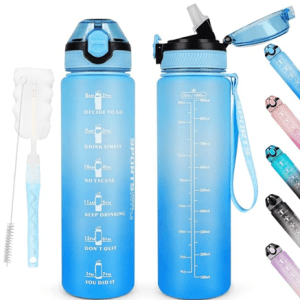 Staying hydrated is generally good advice, but it could also help prevent that awful feeling of seasickness. Dehydration can be a trigger for motion sickness and to make it worse when we’re cruising, we tend to be drinking alcohol and relaxing in the sun which can all add up. By ensuring you’re drinking enough fluids, you will be less prone to headaches, nausea, and dizziness.
Staying hydrated is generally good advice, but it could also help prevent that awful feeling of seasickness. Dehydration can be a trigger for motion sickness and to make it worse when we’re cruising, we tend to be drinking alcohol and relaxing in the sun which can all add up. By ensuring you’re drinking enough fluids, you will be less prone to headaches, nausea, and dizziness.
The cost of bottles of water can add up, so our advice is to take a refillable water bottle with you. Most cruise lines have water filling stations in the buffet area of the ship. We also take a few of the mini squeezy concentrated juices to add to the water, so it has more flavour. Plastic bottles are a better option because they’re lighter than glass drinks containers.
We like this AOHAN water bottle because it’s a good size, has a safe lock cover to make it leakproof and is BPA free.
Limit Your Intake of Alcohol
We know what you’re thinking, you’re on holiday so you’re bound to want to drink alcohol. Well remember what we said about being dehydrated and how it enhances motion sickness. Alcohol is renowned for dehydrating the body and as such it can make your nausea much worse.
What Types of Food Should You Eat During Your Cruise
If you suffer from seasickness then your stomach will be disrupted and uneasy, so it’s important that you feed it foods which won’t be too much of a digestion challenge. Avoid spicy, greasy, and fatty meals during your cruise if you have motion sickness, instead opting for plain dry foods such as unbuttered toast or dry crackers.
Top Tips to Prevent Seasickness
We’ve provided you with everything you need and more to help prevent or reduce the impact of seasickness. But if you’re feeling rough and you need some relief fast then here’s our quick tips.
- Find a spot in the middle of the ship on a deck closer to the water line,
- Drink plenty of water,
- Grab those seabands and put them on, pressing the plastic into your wrist if you need fast relief,
- If the lower deck isn’t working then get some fresh air and look at the horizon,
- Drink some fruit juice for the vitamin c,
- Try the ear plug trick,
- Finally, if none of that is working then grab seasickness pills if you have them and go and lie down in your cabin.
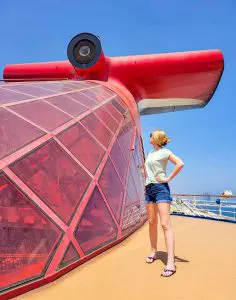 We began this guide on how to prevent seasickness on a cruise, with a number of tips we had accumulated over the years but finished it with a vast number of extra ideas. If needed, we feel well prepared for any rough seas and we hope you feel the same.
We began this guide on how to prevent seasickness on a cruise, with a number of tips we had accumulated over the years but finished it with a vast number of extra ideas. If needed, we feel well prepared for any rough seas and we hope you feel the same.
The best part is that there is a variety of options available, some medicinal, others more natural and then you have the techniques.
Most first-time cruisers are concerned about suffering from sea sickness, its natural. Hopefully with some preparation, even if you are the few who get motion sick then you can stop it in its tracks.
If you have no idea where to begin looking for your cruise, then can we suggest SeaScanner, who collate all the available itineraries from every cruise line operator. It’s where we tend to book our cruises because they have so much on offer and the process is simple.
Should you decide to book a cruise and tick it off your bucket list, or you have one already booked. We wish you a wonderful time and please tag us into your Instagram pictures, we love to see your adventures.